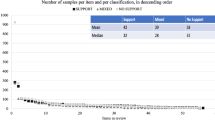Abstract
The present paper summarizes the major methods and results of the multi-dimensional approach to genre variation. The approach combines the resources of computational tools, large text corpora, and multivariate statistical tools (such as factor analysis and cluster analysis). It has been used to address issues such as the relations among spoken and written genres in English, and the historical development of genres and styles. The approach has also been applied to other languages; in this regard it has been used to address broader theoretical issues, such as the extent to which genre, and style variation are comparable cross-linguistically, and the linguistic consequences of literacy.
Similar content being viewed by others
References
Aitken, A.J., R.W. Bailey, and N. Hamilton-Smith, eds. The Computer and Literary Studies. Edinburgh: Edinburgh University Press, 1973.
Besnier, Niko. “The Linguistic Relationships of Spoken and Written Nukulaelae Registers.” Language, 64 (1988), 707–36.
Biber, Douglas. “Spoken and Written Textual Dimensions in English: Resolving the Contradictory Findings.” Language, 62 (1986), 384–414.
Biber, Douglas. “A Textual Comparison of British and American Writing”. American Speech, 62 (1987), 99–119.
Biber, Douglas. Variation across Speech and Writing. Cambridge: Cambridge University Press, 1988.
Biber, Douglas. “A Typology of English Texts.” Linguistics, 27 (1989), 3–43.
Biber, Douglas. “Oral and Literate Characteristics of Selected Primary School Reading Materials.” Text, 11 (1991), 73–96.
Biber, Douglas. “Using Computer-based Text Corpora to Analyze the Referential Strategies of Spoken and Written Texts.” In Directions in Corpus Linguistics, (Proceedings of the Nobel Symposium on Corpus Linguistics, Stockholm, Sweden, August 1991). Ed. Jan Svartvik. Mouton, 1992a, 213–52.
Biber, Douglas. “On the Complexity of Discourse Complexity: A Multidimensional Analysis.” Discourse Processes, 15 (1992b), 133–63.
Biber, Douglas, and Edward Finegan. “Adverbial Stance Types in English.” Discourse Processes, 11 (1988), 1–34.
Biber, Douglas, and Edward Finegan. “Drift and the Evolution of English Style: A History of Three Genres.” Language, 65 (1989a), 487–517.
Biber, Douglas, and Edward Finegan. “Styles of Stance in English: Lexical and Grammatical Marking of Evidentiality and Affect.” Text, 9 (1989b), 93–124.
Biber, Douglas, and Edward Finegan. “The Linguistic Evolution of Five Written and Speech-based English Genres from the 17th to the 20th Centuries.” In History of Englishes: New Methods and Interpretations in Historical Linguistics. Ed. M. Rissanen, O. Ihalainen, T. Nevalainen, and I. Taavitsainen. Mouton, 1992, 688–704.
Biber, Douglas, and Edward Finegan. “Multi-dimensional Analyses of Author's style: Some Case Studies from the 18th century.” To appear in Research in Humanities Computing, 1991.
Biber, Douglas, and Mohamed Hared. “Literacy in Somali: Linguistic Consequences.” Annual Review of Applied Linguistics, 12 (1991), 260–82.
Biber, Douglas, and Mohamed Hared. Linguistic Correlates of the Transition to Literacy in Somali: Language Adaptation in Six Press Registers. In Sociolinguistic Perspectives on Register. Ed. D. Biber and E. Finegan. 1993. (In press, OUP.)
Brown, Penelope, and Colin Fraser. “Speech as a Marker of Situation.” In Social Markers in Speech. Ed. Maus R. Scherer and Howard Giles. Cambridge: Cambridge University Press, 1979, pp. 33–62.
Carroll, J.B. “Vectors of Prose Style.” In Style in Language. Ed. T.A. Sebeok. Cambridge, MA: MIT Press, 1960, pp. 283–92.
Connor-Linton, Jeff. “Author's Style and World-view in Nuclear Discourse: A Quantitative Analysis.” Multilingua, 7 (1988), 95–132.
Ervin-Tripp, Susan M. “On Sociolinguistic Rules: Alternation and Co-occurrence.” In Directions in Sociolinguistics. Ed. John J. Gumperz and Dell Hymes. New York: Holt, Rinehart, and Winston, 1972, pp. 213–50.
Faigley, Lester, and Paul Meyer. “Rhetorical Theory and Readers' Classifications of Text Types.” Text, 3 (1983), 305–25.
Francis, W.N., and H. Kucera. Frequency Analysis of English Usage: Lexicon and Grammar. Boston: Houghton Mifflin, 1982.
Garside, Roger, Geoffrey Leech, and Geoffrey Sampson. The Computational Analysis of English: A Corpus-based Approach. London: Longman, 1987.
Grabe, William. “Contrastive Rhetoric and Text-type Research.” In Writing across Languages: Analysis of L2 Text. Ed. Ulla Connor and Robert B. Kaplan. Reading, MA.: Addison-Wesley, 1987, 115–37.
Hymes, Dell. Foundations in Sociolinguistics: An Ethnographic Approach. Philadelphia: University of Pennsylvania Press, 1974.
Johansson, Stig (with G.N. Leech and H. Goodluck). Manual of information to accompany the Lancaster-Oslo/Bergen Corpus of British English, for use with digital computers. Department of English, University of Oslo, 1978.
Johansson, Stig, and Knut Hofland. Frequency Analysis of English Vocabulary and Grammar Based on the LOB Corpus. Oxford: Clarendon Press, 1989.
Kim, Yong-Jin, and Douglas Biber. “A Corpus-based Analysis of Register Variation in Korean.” In Sociolinguistic Perspectives on Register. Ed. D. Biber and E. Finegan. 1993. (In press, OUP.)
Leech, Geoffrey N., and Michael H. Short. Style in Fiction: A Linguistic Introduction to English Fictional Prose. London: Longman, 1981.
Marckworth, M.L., and Baker, W.J. “A Discriminant Function Analysis of Co-variation of a Number of Syntactic Devices in Five Prose Genres.” American Journal of Computational Linguistics, Microfiche 11 (1974).
Oakman, R.L. “Carlyle and the Machine: A Quantitative Analysis of Syntax in Prose Style.” ALLC Bulletin, 3 (1975), 100–14.
Ross, Donald. “Beyond the Concordance: Algorithms for Description of English Clauses and Phrases.” In Aitken et al., 1973, pp. 85–99.
Sinclair, John M., ed. Looking Up: An Account of the COBVILD Project in Lexical Computing. Glasgow: Collins, 1987.
Svartvik, Jan, ed. The London-Lund Corpus of Spoken English: Description and Research. Lund: Lund University Press, 1990.
Walker, Donald E. “Developing Lexical Resources.” Proceedings of the 5th Annual Conference of the UW Centre for the New Oxford English Dictionary. Waterloo, Ontario: University of Waterloo Centre for the New Oxford English Dictionary, 1989.
Author information
Authors and Affiliations
Additional information
Douglas Biber is an associate professor in the Department of English, Applied Linguistics Program, Northern Arizona University, Flagstaff AZ. His research deals with the linguistic variation among registers and the diachronic evolution of registers, addressing both theoretical concerns and methodological issues relating to the design and use of computer-based text corpora.
Rights and permissions
About this article
Cite this article
Douglas, D. The multi-dimensional approach to linguistic analyses of genre variation: An overview of methodology and findings. Comput Hum 26, 331–345 (1992). https://doi.org/10.1007/BF00136979
Issue Date:
DOI: https://doi.org/10.1007/BF00136979




